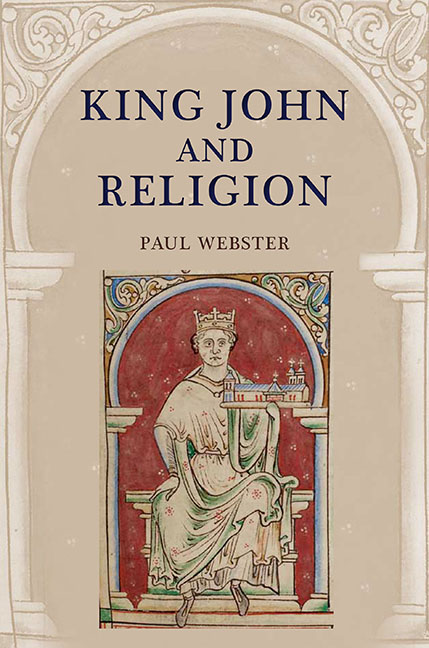Book contents
- Frontmatter
- Dedication
- Contents
- List of Illustrations
- Acknowledgements
- Abbreviations
- Introduction
- 1 The Mass
- 2 The Saints
- 3 Powerhouses of Prayer
- 4 Family
- 5 Charity and Almsgiving
- 6 Religion, Politics, and Reputation: The Interdict and King John’s Excommunication
- 7 Peace with the Pope: Diplomacy, Personal Religion, and Civil War
- 8 King John’s Deathbed and Beyond
- Conclusion
- Bibliography
- Index
- Other volumes in Studies in the History of Medieval Religion
- Frontmatter
- Dedication
- Contents
- List of Illustrations
- Acknowledgements
- Abbreviations
- Introduction
- 1 The Mass
- 2 The Saints
- 3 Powerhouses of Prayer
- 4 Family
- 5 Charity and Almsgiving
- 6 Religion, Politics, and Reputation: The Interdict and King John’s Excommunication
- 7 Peace with the Pope: Diplomacy, Personal Religion, and Civil War
- 8 King John’s Deathbed and Beyond
- Conclusion
- Bibliography
- Index
- Other volumes in Studies in the History of Medieval Religion
Summary
Establishment of religious communities to pray for the founder's soul lay at the heart of elite strategies for securing salvation, creating powerhouses of prayer for themselves and their families. King John was part of this trend, but this is not how he is remembered. Historians view his principal foundation, Beaulieu Abbey (Hampshire), with scepticism. Bishop Stubbs argued that the king had scarcely enough sense of religion to found it. Others see Beaulieu neither as John's idea nor as well-endowed by its founder. Painter describes it as ‘the result of a semipolitical bargain’. Harper-Bill argues that ‘it is clear that the idea was Archbishop Hubert Walter’s, and the investment was little enough for a monarch of John's resources’. Yet the evidence for the king's investment demonstrates that founding monasteries was part of John's religious activity. The project probably began as a penitential act. Hubert Walter, patron and confrater of the Cistercians, certainly played a role in its early stages, mediating when John fell into dispute with the white monks early in the reign. However, the archbishop died in 1205, whilst John showed commitment to Beaulieu across his reign. It represented a significant element of royal desire for intercessory prayer, fitting a family and regnal tradition of establishing houses of ascetic orders. Most significantly, it was a personal religious initiative. John may even have intended to be buried at Beaulieu.
The king's decision to establish a Cistercian house can be seen as an act of atonement for repressive treatment of the order following dispute over taxation. As he sought to secure his continental lands, John reached an agreement with Philip II of France in January 1200, formally confirmed in the Treaty of Le Goulet in May. Under its terms, the English king was obliged to pay twenty thousand marks to his French counterpart. To raise the money, John levied a carucage of three shillings per plough. He demanded this from the Cistercians at York in late March, but the abbots refused, arguing they were exempt unless special permission was granted by the General Chapter. They were presumably also keen to avoid establishing a precedent.
- Type
- Chapter
- Information
- King John and Religion , pp. 61 - 84Publisher: Boydell & BrewerPrint publication year: 2015



